chipgreenberg
Well-known
Again, really nice images and wonderful color palette
j.scooter
Well-known
Wholeheartedly agree with Robert.
This project deserves a book and I am waiting for the link so that I can purchase one.
This project deserves a book and I am waiting for the link so that I can purchase one.
Pál_K
Cameras. I has it.
Nice work.
The soft overexposed impressionistic photos appeal to me. I used to get that with expired Polaroid SX-70 film (the real Polaroid film).
At first the credit card sized prints didn't appeal to me, but I noticed children like having them and like making such photos. After a while, having a collection of them creates a certain aesthetic.
The soft overexposed impressionistic photos appeal to me. I used to get that with expired Polaroid SX-70 film (the real Polaroid film).
At first the credit card sized prints didn't appeal to me, but I noticed children like having them and like making such photos. After a while, having a collection of them creates a certain aesthetic.
Ko.Fe.
Lenses 35/21 Gears 46/20
Those looks way better than from Polaroid I used briefly just before Fuji stopped making instant film for it. I think it was 250 model and it was full kit. But images were not in focus or soft...
Fuji Instax cameras and instant film for it are available almost anywhere in greater Toronto area.
Fuji Instax cameras and instant film for it are available almost anywhere in greater Toronto area.
lynnb
Mentor
Excellent collection of pictures, love the pastel colours and the drama in the monochromes. Lynn for sure your skill as photographer helps you in getting so special results with these cameras. Bravo!
You should really think how to develop this body of work, maybe a small book or a portfolio...
Thanks very much Robert and James - yes, a book would be nice. I’ve no experience in creating photo books but it’s an idea I’d like to try.Wholeheartedly agree with Robert.
This project deserves a book and I am waiting for the link so that I can purchase one.
Thanks David! I’m glad your son liked the pictures too.Lynn,
I was meaning to write last night (sharing it btw with my son who really enjoyed seeing these images) and was pulled away before I hit "reply"
All good because Robert Blu said it all ^^^
Congratulations on this connection you've developed with your Instax. It is so fun to see what can happen with a piece of gear like this when in the hands of someone with experience and vision!
David
I agree Jim, an Instax square or wide designed for advanced amateurs would be a very attractive proposition. They took a risk with the X100 and it paid off handsomely so I hope they take a risk with an Instax for enthusiasts.I too, have a Instax SQ6 and this thread has inspired me to pull it out and use it. In fact, I just bought a few packs of color film for it. My somewhat negative tone was mainly against Fuji, which seems to view Instax as only for amateurs. Their film really is quite good and is much cheaper than Polaroid. If only they made a good camera to take advantage of the good image quality Instax offers.
Jim B.
Thanks Chip! I love the Fuji colors. I’d tried Impossible film a few years ago but it was nowhere near as good. I liked FP100b though… a great shame that’s been discontinued, but Instax wide is very good and cries out for a better camera to take advantage of it.Again, really nice images and wonderful color palette
Thanks Pál_K. At first I thought the small prints would be of lesser interest but I’ve come to regard them as miniatures, which in painting used to be viewed under a magnifier. Scanning and enlarging them works just as well. I’m wondering whether they’d look better in a book as miniatures (i.e. actual picture size 6 x 4.5cm) or enlarged.Nice work. The soft overexposed impressionistic photos appeal to me. I used to get that with expired Polaroid SX-70 film (the real Polaroid film).
At first the credit card sized prints didn't appeal to me, but I noticed children like having them and like making such photos. After a while, having a collection of them creates a certain aesthetic.
Hi Kostya, I’m surprised the Polaroid 250 images were soft. I used one on loan once and found it was pretty good. Maybe you should try Instax. The film’s way cheaper than Polaroid that’s for sure. I look out for eBay discounts when I buy it.Those looks way better than from Polaroid I used briefly just before Fuji stopped making instant film for it. I think it was 250 model and it was full kit. But images were not in focus or soft...
Fuji Instax cameras and instant film for it are available almost anywhere in greater Toronto area.
Bmoze
Established
Very interesting and thanks for explaining it. Great body of work.
I wonder if there’s a way to show these to Fuji? I mean, what a great example and promo for the Instax cameras and film.
I wonder if there’s a way to show these to Fuji? I mean, what a great example and promo for the Instax cameras and film.
lynnb
Mentor
Social photography and selfies
It would be remiss of me not to show what these cameras were designed for (they have a mirror on the front of the camera to make it easy to frame selfies), so here's a few pictures that help explain why Fujifilm's Instax has been a commercial success in a time when film sales have dropped off a cliff since the advent of cell phones.
Picture #102. Me with my daughter's cat during COVID-19 lockdown, using the close up filter. Shot at f/12.7 (wide open)
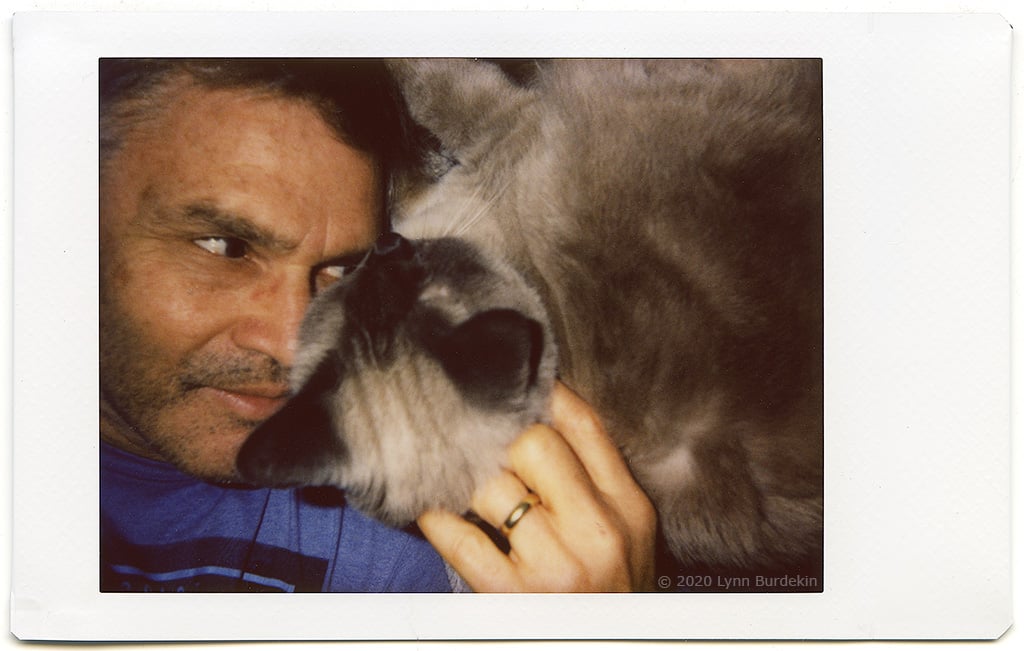
Picture #104. On the cliff path close to where I live. Not too bad for a 2-element plastic lens, with some careful unsharp masking in Photoshop CS6. I thought the flash did a good job of balancing ambient light. Shot at F/32.
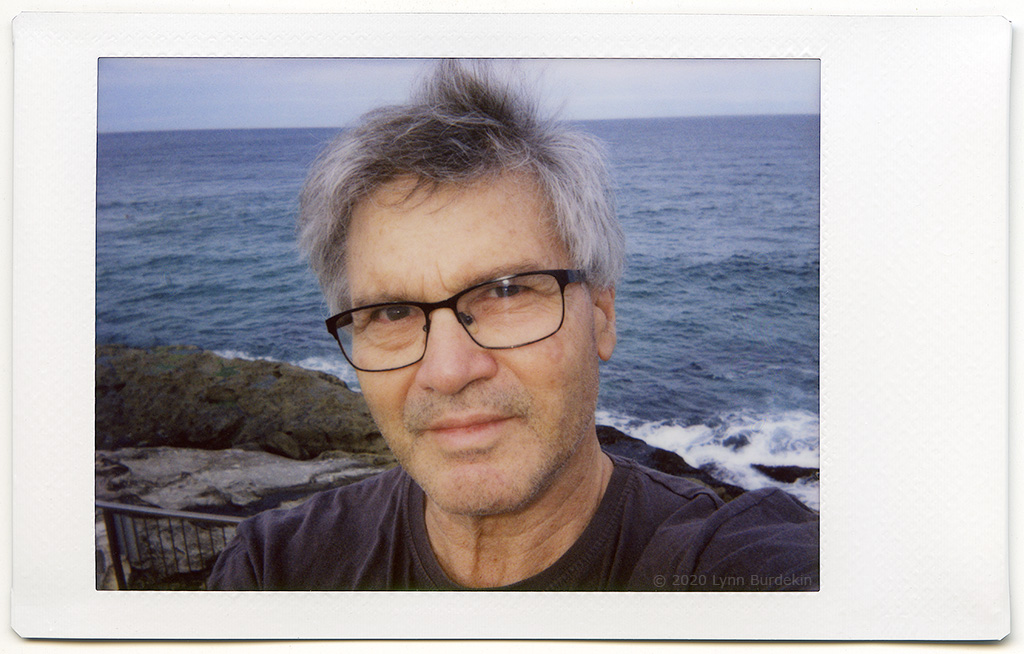
It would be remiss of me not to show what these cameras were designed for (they have a mirror on the front of the camera to make it easy to frame selfies), so here's a few pictures that help explain why Fujifilm's Instax has been a commercial success in a time when film sales have dropped off a cliff since the advent of cell phones.
Picture #102. Me with my daughter's cat during COVID-19 lockdown, using the close up filter. Shot at f/12.7 (wide open)

Picture #104. On the cliff path close to where I live. Not too bad for a 2-element plastic lens, with some careful unsharp masking in Photoshop CS6. I thought the flash did a good job of balancing ambient light. Shot at F/32.

lynnb
Mentor
Picture #166. OK, I couldn't resist including a picture of my other daughter's cat, a 17 yr old Ragdoll. She has the most beautiful blue eyes, so naturally chooses to pose on my blue computer chair to bring them out. I can't get her off the chair without giving her a tummy rub. Her coat has been shorn from the neck down because her super fine fur got matted. Taken at f/12.7 with the close up filter.
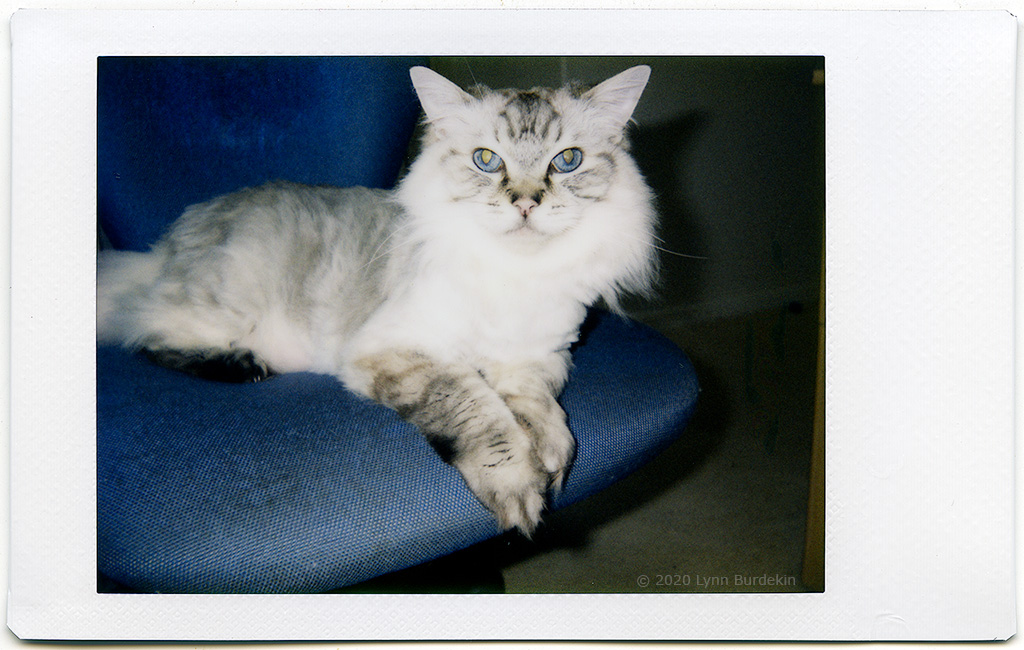

lynnb
Mentor
Picture #125. I figured one way to get greater impact from the small Instax Mini format is to do a Warhol...
Taken with the close up filter and compiled in CS6.
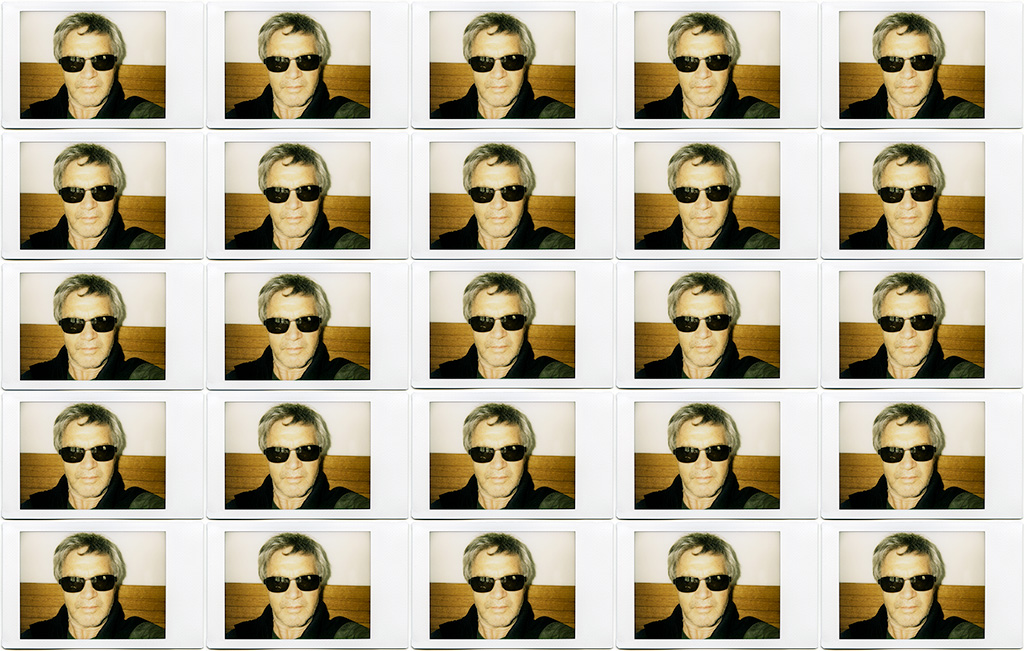
Taken with the close up filter and compiled in CS6.

lynnb
Mentor
Picture #129. My wife and I out for some exercise and a coffee at the beach. It's quite easy to frame more than one person with the small selfie mirror. f/32 in bright sunlight so there's some overexposure. Note the flash always fires on the Instax Mini 9. Since getting the Instax my wife has become much happier about the pictures I take of her - she says the film makes her look good. This is great because I can keep buying Instax film 


lynnb
Mentor
After Tarkovsky
One of my favourite photo books is Instant Light - Tarkovsky Polaroids (Thames & Hudson, ISBN 9780500286142. I think it's out of print now). I thought of his images when I saw this light and shadow in a local park.
Picture #98 "After Tarkovsky"
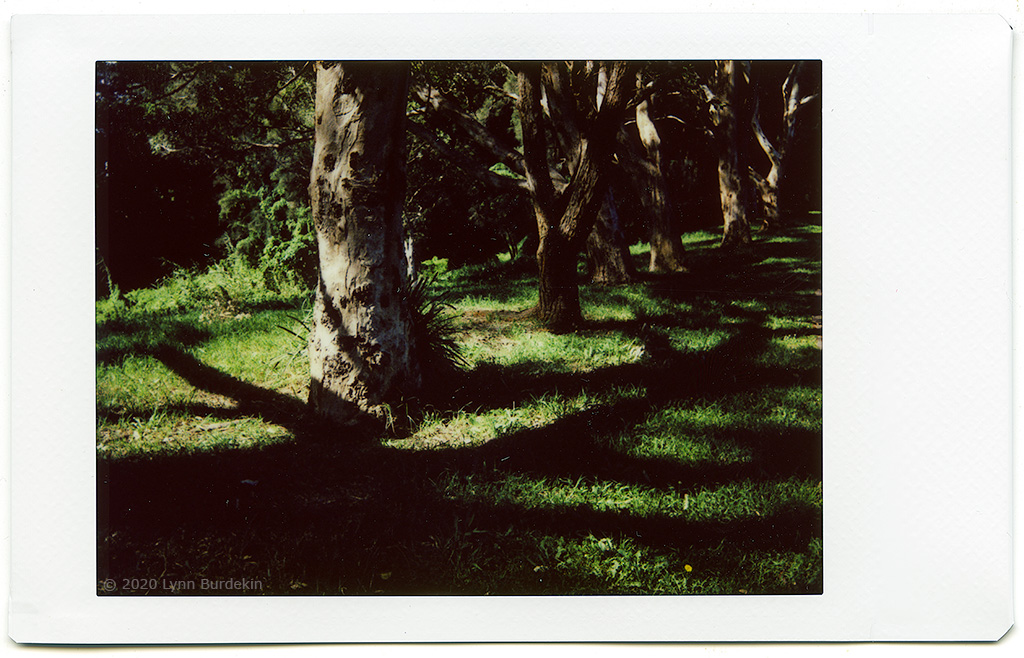
Picture #96
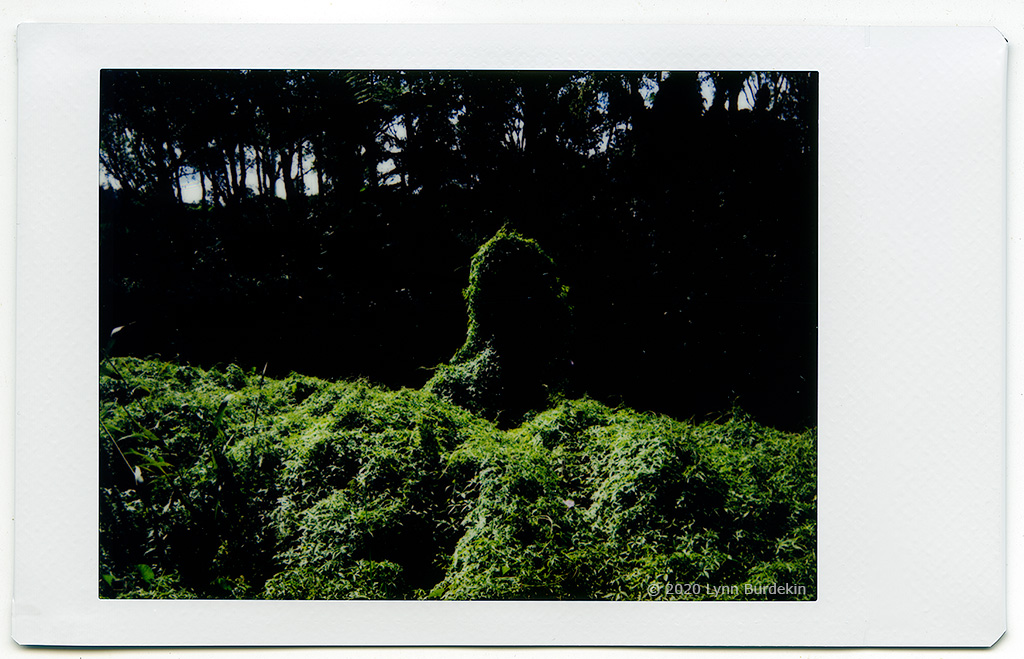
One of my favourite photo books is Instant Light - Tarkovsky Polaroids (Thames & Hudson, ISBN 9780500286142. I think it's out of print now). I thought of his images when I saw this light and shadow in a local park.
Picture #98 "After Tarkovsky"

Picture #96

lynnb
Mentor
Another picture from the park, Instax Mini 800 color film converted to sepia in Lightroom 6.
Picture #101
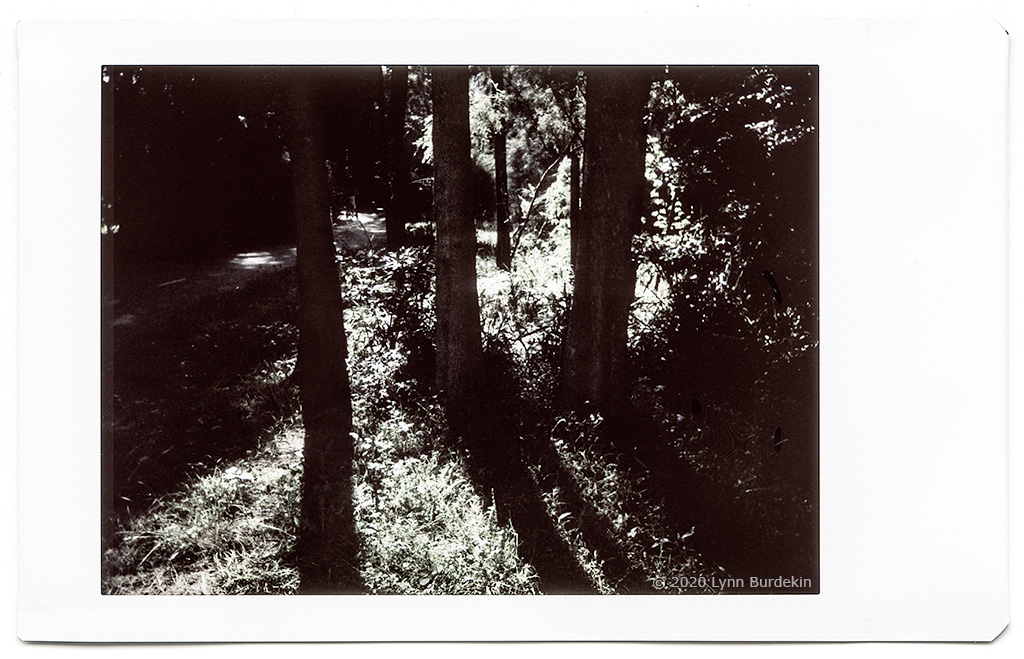
Picture #101

lynnb
Mentor
The Instax Mini 9 with plastic close up filter attached. The filter clips on but is easily dislodged. You can see the selfie mirror next to the flat side of the filter. The focus range with the filter is 0.3m to 0.6m. The lens extends with a spring loaded button to turn the camera on. The two small holes in the middle of the camera are the exposure meter.
The Mini 9 will fit into a jacket pocket or ride along in my small Billingham camera bag, along with a CL or Barnack and a few lenses.
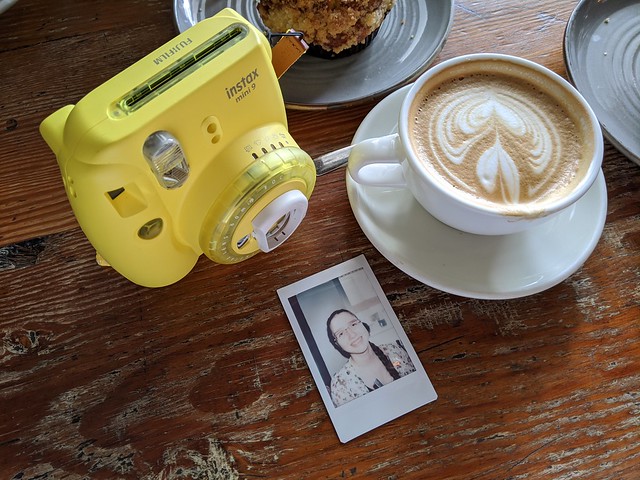
The Mini 9 will fit into a jacket pocket or ride along in my small Billingham camera bag, along with a CL or Barnack and a few lenses.

lynnb
Mentor
Thanks! Fuji Australia is headquartered a few minutes' drive from my place. I might contact the Marketing Manager and see if he's interested.Very interesting and thanks for explaining it. Great body of work.
I wonder if there’s a way to show these to Fuji? I mean, what a great example and promo for the Instax cameras and film.
lynnb
Mentor
Recovering accidental overexposures
The aperture defaults to f/12.7 whenever the Instax Mini 9 is turned on. It’s easy to forget to reset the aperture to current light conditions if you’ve been using it and turn it off temporarily to avoid draining the batteries (it uses two AA batteries that last around 10 film packs, i.e. 100 photos). This has resulted in a few accidental overexposures of around 3-4 stops when shooting in bright conditions. What you get is an almost white frame with a very faint image. It looks unsalvageable but as it turns out all is not lost.
Scanning the image and applying contrast in post can rescue some detail from that almost-white print. The result can be quite beautiful. Judge for yourself.
Picture #91
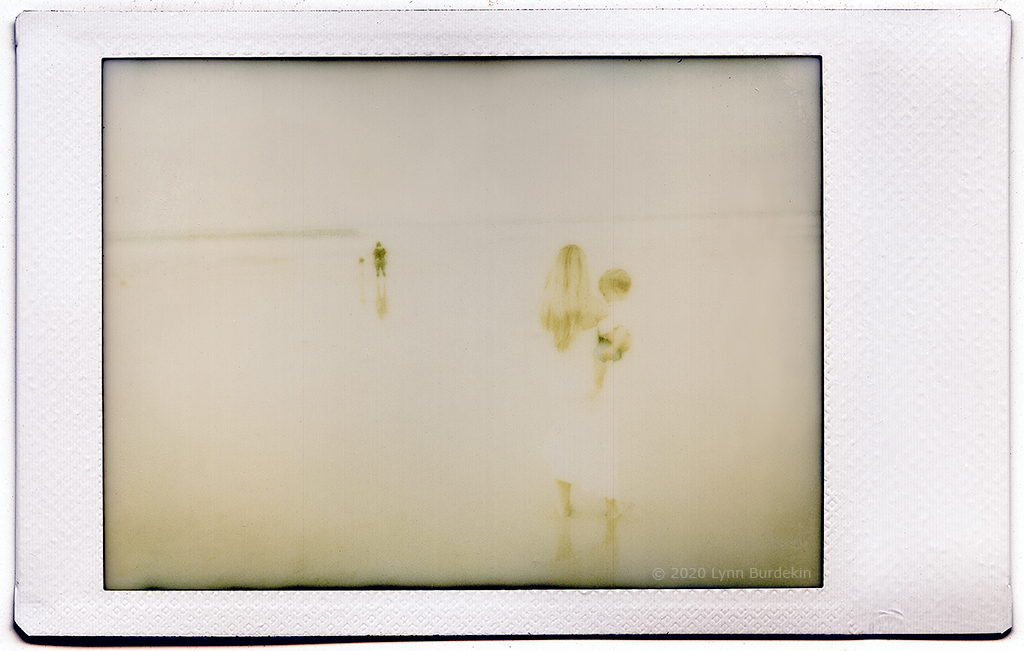
Picture #92
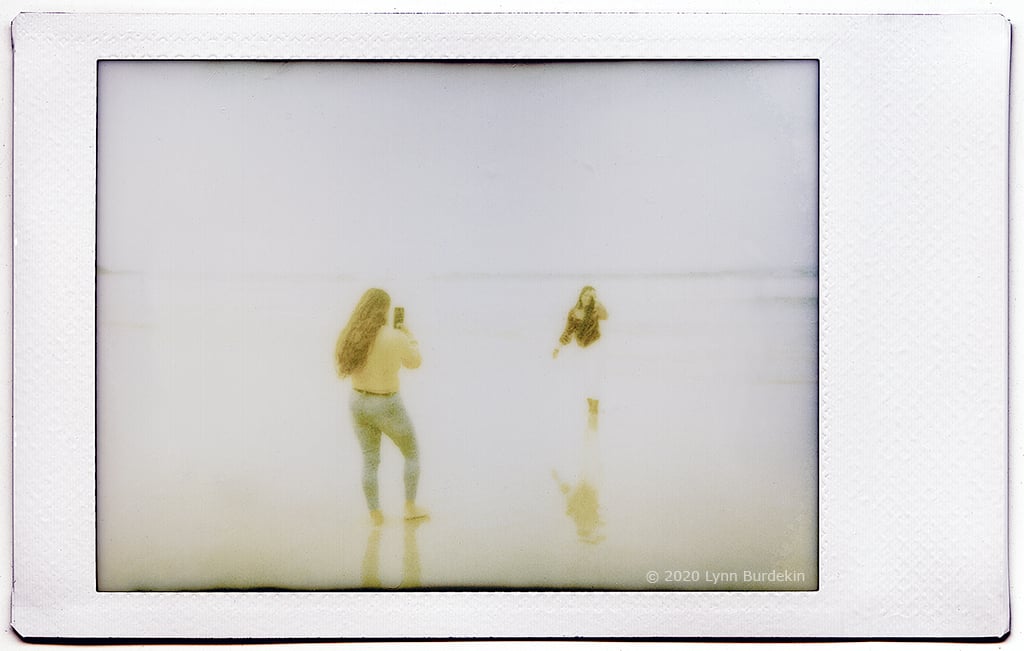
The aperture defaults to f/12.7 whenever the Instax Mini 9 is turned on. It’s easy to forget to reset the aperture to current light conditions if you’ve been using it and turn it off temporarily to avoid draining the batteries (it uses two AA batteries that last around 10 film packs, i.e. 100 photos). This has resulted in a few accidental overexposures of around 3-4 stops when shooting in bright conditions. What you get is an almost white frame with a very faint image. It looks unsalvageable but as it turns out all is not lost.
Scanning the image and applying contrast in post can rescue some detail from that almost-white print. The result can be quite beautiful. Judge for yourself.
Picture #91

Picture #92

lynnb
Mentor
Going bigger: the Instax Wide 300
Having been surprised by what’s possible with the Instax Mini 9 - and having learnt some lessons on the smaller (and cheaper) format - I started t̶h̶i̶n̶k̶i̶n̶g̶ ̶a̶b̶o̶u̶t̶ lusting for the Instax Wide 300. The Instax Wide’s 98 x 62mm picture area is twice the size of the Instax Mini’s 62 x 46mm.
Encouraged by RFF user Brad Bireley’s Instax Wide 300 pictures I gave into temptation after finding one 40% discounted.
The Instax Wide 300 is a Big Plastic Camera. When you think about it, it’s a non-folding 6x9 autofocus medium format camera so its size shouldn't be a surprise. The lens is a 95mm 2-element f/14 plastic lens. Why Fuji? Here it is with a box of HP5+ for comparison. Pocketable, this is not. Specifications here.
A good thing about the Instax Wide 300 is that you can turn the flash off. Another good thing is that the shutter speeds go from 1/64 to 1/200, so there’s less risk of overexposure in bright light. Instax Wide film is ISO800, the same as Instax Mini film.
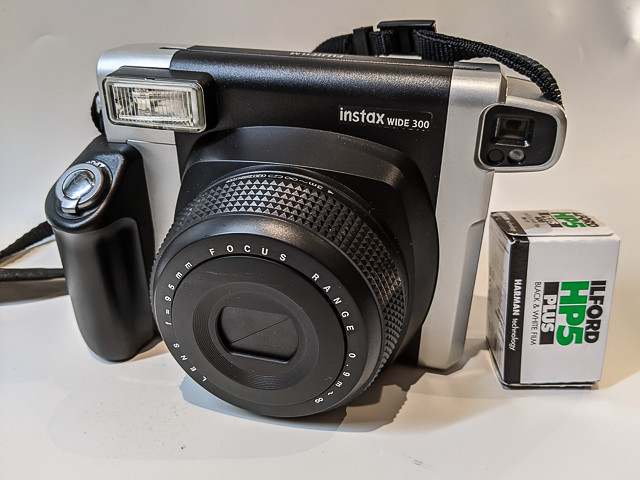

One the right - Instax Wide vs Instax Mini prints

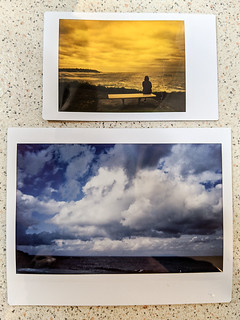
I call this my stealth camera
Having been surprised by what’s possible with the Instax Mini 9 - and having learnt some lessons on the smaller (and cheaper) format - I started t̶h̶i̶n̶k̶i̶n̶g̶ ̶a̶b̶o̶u̶t̶ lusting for the Instax Wide 300. The Instax Wide’s 98 x 62mm picture area is twice the size of the Instax Mini’s 62 x 46mm.
Encouraged by RFF user Brad Bireley’s Instax Wide 300 pictures I gave into temptation after finding one 40% discounted.
The Instax Wide 300 is a Big Plastic Camera. When you think about it, it’s a non-folding 6x9 autofocus medium format camera so its size shouldn't be a surprise. The lens is a 95mm 2-element f/14 plastic lens. Why Fuji? Here it is with a box of HP5+ for comparison. Pocketable, this is not. Specifications here.
A good thing about the Instax Wide 300 is that you can turn the flash off. Another good thing is that the shutter speeds go from 1/64 to 1/200, so there’s less risk of overexposure in bright light. Instax Wide film is ISO800, the same as Instax Mini film.


One the right - Instax Wide vs Instax Mini prints


I call this my stealth camera
lynnb
Mentor
First pictures with the Instax Wide
Picture W#003. The first two pictures were of my wife. I am learning good sense. These are clouds off the Sydney coast, with a COVID-infected cruise ship on the horizon, stranded after being denied entry to Sydney harbour in late March 2020. The lens vignettes, and Fuji really knows how to do blues.
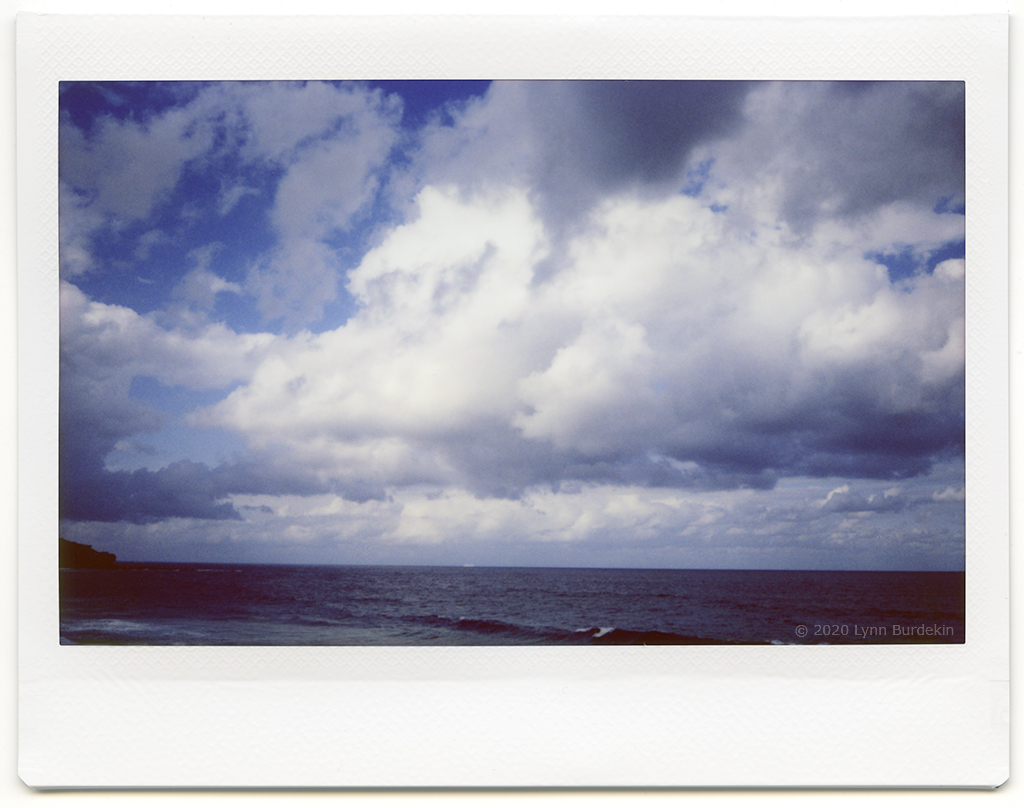
Picture W#003. The first two pictures were of my wife. I am learning good sense. These are clouds off the Sydney coast, with a COVID-infected cruise ship on the horizon, stranded after being denied entry to Sydney harbour in late March 2020. The lens vignettes, and Fuji really knows how to do blues.

lynnb
Mentor
Picture W#019
It does a good job on reds and yellows too. The sand colour seems accurate as well. This is my local Freshwater beach, in Sydney.
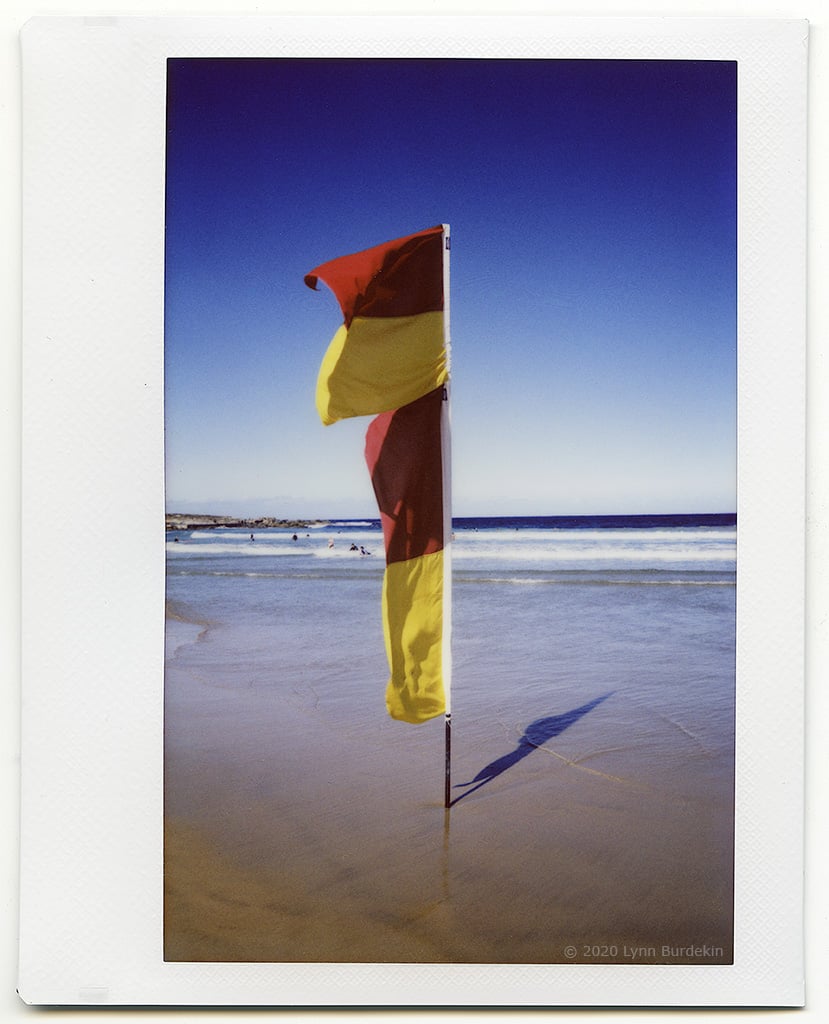
It does a good job on reds and yellows too. The sand colour seems accurate as well. This is my local Freshwater beach, in Sydney.

Brad Bireley
Well-known
Going bigger: the Instax Wide 300
Having been surprised by what’s possible with the Instax Mini 9 - and having learnt some lessons on the smaller (and cheaper) format - I started t̶h̶i̶n̶k̶i̶n̶g̶ ̶a̶b̶o̶u̶t̶ lusting for the Instax Wide 300. The Instax Wide’s 98 x 62mm picture area is twice the size of the Instax Mini’s 62 x 46mm.
Encouraged by RFF user Brad Bireley’s Instax Wide 300 pictures I gave into temptation after finding one 40% discounted.
The Instax Wide 300 is a Big Plastic Camera. When you think about it, it’s a non-folding 6x9 autofocus medium format camera so its size shouldn't be a surprise. The lens is a 95mm 2-element f/14 plastic lens. Why Fuji? Here it is with a box of HP5+ for comparison. Pocketable, this is not. Specifications here.
A good thing about the Instax Wide 300 is that you can turn the flash off. Another good thing is that the shutter speeds go from 1/64 to 1/200, so there’s less risk of overexposure in bright light. Instax Wide film is ISO800, the same as Instax Mini film.



I call this my stealth camera
Thanks for the plug Lynn. Your photos are wonderful! Have you tried to use the Wide 300 in not real low light , but low light with the flash turned off? When I do it the flash still fires.
lynnb
Mentor
I'm not sure Brad. It's fired when I've taken some low light pictures but I can't remember if I turned the flash off. Thanks for the compliment!Thanks for the plug Lynn. Your photos are wonderful! Have you tried to use the Wide 300 in not real low light , but low light with the flash turned off? When I do it the flash still fires.
Share:
-
This site uses cookies to help personalise content, tailor your experience and to keep you logged in if you register.
By continuing to use this site, you are consenting to our use of cookies.

